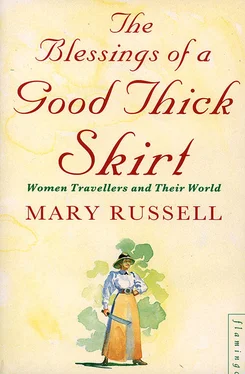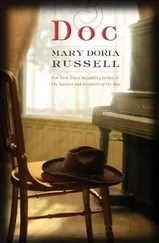By the eighth century, the pilgrim route had become something of a tourist trek with many of the delays, frustrations and unexpected expenses that one might encounter today. Sea-captains refused to allow their passengers to leave ship until they had paid the airport tax of the day, known euphemistically as a ‘disembarcation fee’. Travellers passing through non-Christian areas were subjected to poll taxes which varied according to their apparent wealth, and one traveller commenting on the bureaucracy of the day, no less autocratic then than now, noted in disgust that ‘anyone who is found by night or day without a paper or a stamp issued by one of the kings or princes of that country is sent to prison … until he can prove he is not a spy’.
None of these inconveniences, however, deterred women from the journey, and indeed so numerous were they on the road to Rome that they presented a special problem to the church authorities whose attempts to restrain this restless tide were at first paternalistic and benign but were soon revealed in their true, repressive colours. ‘It would be well and favourable,’ wrote Boniface to the Archbishop of Canterbury, ‘… if your synod would forbid matrons and veiled women to make these frequent journeys back and forth to Rome.’ To have wives and mothers straying so far from home was an obvious threat to the institution of marriage. Not only that: despite their respectable status, such matrons, it seems, were in danger of falling by the wayside as so many of their sisters had done previously. ‘For,’ the anxious cleric continued, ‘there are few towns [along the way] in which there is not a courtesan or a harlot of English stock.’ He might have taken a more charitable view of his fallen sisters, as one of his predecessors did. St Marcianus, in the fifth century, persuaded a number of prostitutes to reform and to demonstrate their new way of life by making the pilgrimage to Jerusalem – a journey which he thoughtfully financed himself.
Banditry, piracy, prostitution and smuggling – it was all a long way from the vision of a young, wistful, Anglo-Saxon girl, exiled in a German monastery, who had to content herself with being a second-hand traveller.
I, unworthy child of the Saxon race, the last of those who have come hither from their land who am, in comparison with these my countrymen, not only in years but in virtue also, only a poor little creature … Yet I am a woman, tainted with the frailty of my sex, with no pretensions to wisdom or cleverness to support me, but prompted solely by the violence of my own will like a little ignorant child plucking a few flowers here and there from numerous branches rich in foliage and in fruit.
With painful humility the young Huceburg, amanuensis for the first Englishman to travel to Jerusalem, sat down to write what is the earliest English travel book still available to us.
She had been sent from England to the monastery of Heidenheim, in Germany, where her cousin was Abbess. While there, another member of her family, the monk Willibald, now an old man, returned from his travels to dictate his book to the wide-eyed young girl. The guidebook. The Hodaeporicon, written about 780, is full of stories that must have amazed her – how the party saw a lion, how they were arrested by the Saracens on suspicion of spying, how Willibald, later Saint Willibald, smuggled balsam through the customs. First he filled a calabash with the balsam, then he took a hollow cane, filled that with petroleum and concealed it in the calabash so that when the officials came to examine the calabash they were distracted by the smell of petroleum and the balsam went undetected.
Huceburg was the product of her religious education, trained to view herself as a woman and therefore less than nothing, but there was nothing humble about Margery Kempe, the mayor’s daughter from Bishop’s Lynn who, in 1413, set sail for Jerusalem with a party of pilgrims whose collective and determined aim was to lose her as quickly as they could.
By the fifteenth century, women, despite the prohibitive antics of the church, had established themselves as regular and seasoned travellers on the pilgrim run. Their enthusiasm and ebullient response to religious ceremonies could, at times, be somewhat of an embarrassment but their presence was vital to a church which thrived on ignorance and superstition. It is the women, after all, who keep the candles burning and who see, through the hypnotic haze, the strange shadows of moving statues.
Margery Kempe, voluble, energetic, given to hearing voices and seeing visions, was born in 1373 and at the age of forty set out on a five-month journey to Jerusalem. Margery was obsessed with holiness – her own and everyone else’s – and constantly harangued her companions to pray when they would rather have been carousing. Although the threat of piracy had lessened since the Venetian Senate had required all galleys to carry bows, arrows and lances for their own protection, it was still a nerve-wracking journey and most of Margery’s companions preferred to take their minds off their fears by drinking and playing cards.
When the pilgrim band reached Jaffa, Margery was so excited at the prospect of seeing Jerusalem that she fell off her donkey and two kind Germans had to help her back on, one of them even going so far as to feed her with spices to ward off travel sickness. It was in Jerusalem that the pilgrimage proper began, with a seemingly endless round of visits to churches, to the River Jordan, and to Bethlehem. Here, Margery’s sanctity took hold of her in earnest and ‘she fell down because she could not stand or kneel and rolled and wrested with her body, spreading her arms and crying with a loud voice as though her heart burst asunder’. Understandably, the rest of the group thought it best to disassociate itself from this excessive and unseemly display of fervour. On the journey home, they frequently managed to give her the slip and she often found herself trudging alone along unknown roads through foreign countries fearing for her good name. Occasionally, she managed to attach herself to another party or, when the worst came to the worst, to hitch a lift on a passing haycart.
Margery Kempe holds an important position in the history of women travellers. Like many before and after her, she took to the whole paraphernalia of travel with the noisy delight of a drake getting her first sight of water. Although a matron of comfortable means, she stoically endured hardship, danger and illness during the two years she was away from home. Despite the unchristian behaviour of her companions, who cut up her clothes, stole her bed sheets and walked too fast for her, she displayed a dogged determination to complete what she had set out to do. Like many women travellers, however, she enjoyed a privileged position in her own society and it was this which enabled her confidently to deal with officials and critics alike.
In one major aspect, however, she differed from most of the women travellers who were to follow her. She was both ill-educated and ill-prepared to benefit intellectually from her experiences. She died in 1438, untouched by the ripples of humanism and radical religious thinking that were beginning to disturb, yet again, the relatively calm pond of English society. She left behind, however, a record of her travels and the final irony in her tale is that this unique book – the earliest autobiographical travel account still in existence to be written in the vernacular – had to be dictated, for this most exuberant and talkative of women travellers could neither read nor write.
Such a state of ignorance would have been unendurable for those women living around the time of the English Civil War whose lives, for a time, depended on their wits, and consisted of a series of hurried and dangerous escapes made under cover, frequently in disguise and usually at dead of night. Their journeys – hazardous and solitary – were ones they would rather not have made.
Читать дальше












